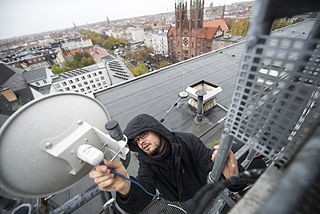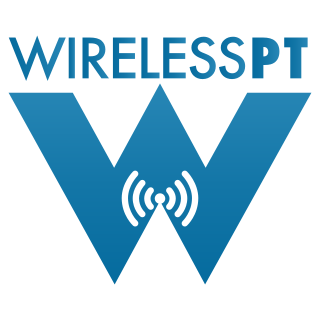
A wireless network is a computer network that uses wireless data connections between network nodes. Wireless networking allows homes, telecommunications networks and business installations to avoid the costly process of introducing cables into a building, or as a connection between various equipment locations. Admin telecommunications networks are generally implemented and administered using radio communication. This implementation takes place at the physical level (layer) of the OSI model network structure.

Wireless community networks or wireless community projects or simply community networks, are non-centralized, self-managed and collaborative networks organized in a grassroots fashion by communities, non-governmental organizations and cooperatives in order to provide a viable alternative to municipal wireless networks for consumers.

Wi-Fi is a family of wireless network protocols based on the IEEE 802.11 family of standards, which are commonly used for local area networking of devices and Internet access, allowing nearby digital devices to exchange data by radio waves. These are the most widely used computer networks, used globally in home and small office networks to link devices and to provide Internet access with wireless routers and wireless access points in public places such as coffee shops, hotels, libraries, and airports.

In computer networking, a wireless access point, or more generally just access point (AP), is a networking hardware device that allows other Wi-Fi devices to connect to a wired network or wireless network. As a standalone device, the AP may have a wired or wireless connection to a router or router, but, in a wireless router, it can also be an integral component of the networking devices itself. An WAP & AP is differentiated from a hotspot, which can be a physical location or digital location where Wi-Fi or WAP access is available.
Linksys Holdings, Inc., is an American brand of data networking hardware products mainly sold to home users and small businesses. It was founded in 1988 by the couple Victor and Janie Tsao, both Taiwanese immigrants to the United States. Linksys products include Wi-Fi routers, mesh Wi-Fi systems, Wifi extenders, access points, network switches, and Wi-Fi networking. It is headquartered in Irvine, California.

A wireless mesh network (WMN) is a communications network made up of radio nodes organized in a mesh topology. It can also be a form of wireless ad hoc network.

A hotspot is a physical location where people can obtain Internet access, typically using Wi-Fi technology, via a wireless local-area network (WLAN) using a router connected to an Internet service provider.

A wireless network interface controller (WNIC) is a network interface controller which connects to a wireless network, such as Wi-Fi, Bluetooth, or LTE (4G) or 5G rather than a wired network, such as an Ethernet network. A WNIC, just like other NICs, works on the layers 1 and 2 of the OSI model and uses an antenna to communicate via radio waves.

Wireless security is the prevention of unauthorized access or damage to computers or data using wireless networks, which include Wi-Fi networks. The term may also refer to the protection of the wireless network itself from adversaries seeking to damage the confidentiality, integrity, or availability of the network. The most common type is Wi-Fi security, which includes Wired Equivalent Privacy (WEP) and Wi-Fi Protected Access (WPA). WEP is an old IEEE 802.11 standard from 1997. It is a notoriously weak security standard: the password it uses can often be cracked in a few minutes with a basic laptop computer and widely available software tools. WEP was superseded in 2003 by WPA, a quick alternative at the time to improve security over WEP. The current standard is WPA2; some hardware cannot support WPA2 without firmware upgrade or replacement. WPA2 uses an encryption device that encrypts the network with a 256-bit key; the longer key length improves security over WEP. Enterprises often enforce security using a certificate-based system to authenticate the connecting device, following the standard 802.11X.
Monitor mode, or RFMON mode, allows a computer with a wireless network interface controller (WNIC) to monitor all traffic received on a wireless channel. Unlike promiscuous mode, which is also used for packet sniffing, monitor mode allows packets to be captured without having to associate with an access point or ad hoc network first. Monitor mode only applies to wireless networks, while promiscuous mode can be used on both wired and wireless networks. Monitor mode is one of the eight modes that 802.11 wireless adapter can operate in: Master, Managed, Ad hoc, Repeater, Mesh, Wi-Fi Direct, TDLS and Monitor mode.
A wireless ad hoc network (WANET) or mobile ad hoc network (MANET) is a decentralized type of wireless network. The network is ad hoc because it does not rely on a pre-existing infrastructure, such as routers or wireless access points. Instead, each node participates in routing by forwarding data for other nodes. The determination of which nodes forward data is made dynamically on the basis of network connectivity and the routing algorithm in use.

The Better Approach to Mobile Ad-hoc Networking (B.A.T.M.A.N.) is a routing protocol for multi-hop mobile ad hoc networks which is under development by the German "Freifunk" community and intended to replace the Optimized Link State Routing Protocol (OLSR) as OLSR did not meet the performance requirements of large-scale mesh deployments.
IEEE 802.11s is a wireless local area network (WLAN) standard and an IEEE 802.11 amendment for mesh networking, defining how wireless devices can interconnect to create a wireless LAN mesh network, which may be used for relatively fixed topologies and wireless ad hoc networks. The IEEE 802.11s task group drew upon volunteers from university and industry to provide specifications and possible design solutions for wireless mesh networking. As a standard, the document was iterated and revised many times prior to finalization.
OpenWrt is an open-source project for embedded operating systems based on Linux, primarily used on embedded devices to route network traffic. The main components are Linux, util-linux, musl, and BusyBox. All components have been optimized to be small enough to fit into the limited storage and memory available in home routers.
Ninux.org is a wireless community network in Italy, a free, open and experimental computer network. The main idea is that users build their own computer network without central control or property, as opposed to traditional Internet service providers (ISP), where a single entity owns and manages the network. The initiative is based on the Ninux manifesto, the Wireless Commons Manifesto and the Picopeering Agreement. In these agreements participants agree upon a network that is free from discrimination, in the sense of net neutrality.
Smartphone ad hoc networks are wireless ad hoc networks that use smartphones. Once embedded with ad hoc networking technology, a group of smartphones in close proximity can together create an ad hoc network. Smart phone ad hoc networks use the existing hardware in commercially available smartphones to create peer-to-peer networks without relying on cellular carrier networks, wireless access points, or traditional network infrastructure. Wi-Fi SPANs use the mechanism behind Wi-Fi ad-hoc mode, which allows phones to talk directly among each other, through a transparent neighbor and route discovery mechanism. SPANs differ from traditional hub and spoke networks, such as Wi-Fi Direct, in that they support multi-hop routing and relays and there is no notion of a group leader, so peers can join and leave at will without destroying the network.

Wirelesspt is a non-commercial open grassroots initiative to support free computer networks that is not dependent of central infrastructure, corporation or entity which is done by the ordinary citizen provide free, open and democratic access to the highways of information technologies helping people and organizations implementing wireless networks that will benefit their communities.
NYC Mesh is a physical network of interconnected routers and a group of enthusiasts working to support the expansion of the project as a freely accessible, open, wireless community network. NYC Mesh is not an Internet service provider (ISP), although it does connect to the internet and offer internet access as a service to members. The network includes over 1,200 active member nodes throughout the five boroughs of New York City, with concentrations of users in lower Manhattan and Brooklyn.












